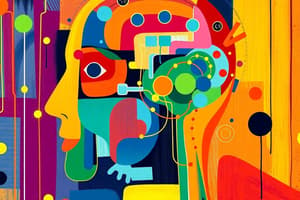Podcast
Questions and Answers
What is the primary goal of supervised learning?
What is the primary goal of supervised learning?
- To reduce the complexity of an algorithm
- To interact with an environment and receive feedback
- To make predictions or decisions based on labeled data (correct)
- To discover patterns in unlabeled data
Which machine learning algorithm is inspired by the structure and function of the human brain?
Which machine learning algorithm is inspired by the structure and function of the human brain?
- Random Forest
- Neural Networks (correct)
- Decision Trees
- Linear Regression
What occurs when an algorithm is too complex and performs well on training data but poorly on new, unseen data?
What occurs when an algorithm is too complex and performs well on training data but poorly on new, unseen data?
- Bias-Variance Tradeoff
- Overfitting (correct)
- Underfitting
- Reinforcement Learning
Which of the following is an example of unsupervised learning?
Which of the following is an example of unsupervised learning?
What is the primary goal of reinforcement learning?
What is the primary goal of reinforcement learning?
What is the term for the balance between an algorithm's ability to fit the training data and its ability to generalize to new data?
What is the term for the balance between an algorithm's ability to fit the training data and its ability to generalize to new data?
What type of machine learning algorithm is used for image and speech recognition, natural language processing, and more?
What type of machine learning algorithm is used for image and speech recognition, natural language processing, and more?
What occurs when an algorithm is too simple and fails to capture the underlying patterns in the data?
What occurs when an algorithm is too simple and fails to capture the underlying patterns in the data?
What is the primary goal of unsupervised learning?
What is the primary goal of unsupervised learning?
Which machine learning algorithm is an ensemble learning method?
Which machine learning algorithm is an ensemble learning method?
What type of machine learning is used when an algorithm learns from interacting with an environment and receiving feedback?
What type of machine learning is used when an algorithm learns from interacting with an environment and receiving feedback?
What is the main difference between supervised and unsupervised learning?
What is the main difference between supervised and unsupervised learning?
Which machine learning algorithm is used for predicting a continuous output variable?
Which machine learning algorithm is used for predicting a continuous output variable?
What is the term for the ability of a model to generalize to new, unseen data?
What is the term for the ability of a model to generalize to new, unseen data?
Which of the following is a consequence of underfitting?
Which of the following is a consequence of underfitting?
What is the key to avoiding overfitting in machine learning?
What is the key to avoiding overfitting in machine learning?
Flashcards are hidden until you start studying
Study Notes
Machine Learning
Machine learning is a subset of artificial intelligence (AI) that involves training algorithms to learn from data and make predictions or decisions without being explicitly programmed.
Types of Machine Learning:
- Supervised Learning: The algorithm is trained on labeled data to learn the relationship between input and output.
- Example: Image classification, where the algorithm learns to classify images as "dog" or "cat" based on labeled training data.
- Unsupervised Learning: The algorithm is trained on unlabeled data to discover patterns or relationships.
- Example: Clustering customers based on their buying behavior to identify target markets.
- Reinforcement Learning: The algorithm learns by interacting with an environment and receiving feedback in the form of rewards or penalties.
- Example: Training an AI to play a game by rewarding it for winning and penalizing it for losing.
Machine Learning Algorithms:
- Linear Regression: A linear model that predicts a continuous output variable based on one or more input features.
- Decision Trees: A tree-based model that splits data into subsets based on features and makes predictions.
- Random Forest: An ensemble model that combines multiple decision trees to improve accuracy and reduce overfitting.
- Neural Networks: A model inspired by the structure and function of the human brain, used for image and speech recognition, natural language processing, and more.
Key Concepts:
- Overfitting: When an algorithm is too complex and performs well on training data but poorly on new, unseen data.
- Underfitting: When an algorithm is too simple and fails to capture the underlying patterns in the data.
- Bias-Variance Tradeoff: The balance between an algorithm's ability to fit the training data (bias) and its ability to generalize to new data (variance).
- Gradient Descent: An optimization algorithm used to minimize the loss function and find the optimal parameters for a machine learning model.
Applications:
- Image and Speech Recognition: Machine learning is used to develop systems that can recognize and classify images and speech.
- Natural Language Processing: Machine learning is used to develop systems that can understand and generate human language.
- Recommendation Systems: Machine learning is used to develop systems that can recommend products or services based on user behavior and preferences.
Machine Learning
- Machine learning is a subset of artificial intelligence that involves training algorithms to learn from data and make predictions or decisions without being explicitly programmed.
Types of Machine Learning
- Supervised Learning: Trained on labeled data to learn the relationship between input and output, example: Image classification, where the algorithm learns to classify images as "dog" or "cat" based on labeled training data.
- Unsupervised Learning: Trained on unlabeled data to discover patterns or relationships, example: Clustering customers based on their buying behavior to identify target markets.
- Reinforcement Learning: Learns by interacting with an environment and receiving feedback in the form of rewards or penalties, example: Training an AI to play a game by rewarding it for winning and penalizing it for losing.
Machine Learning Algorithms
- Linear Regression: A linear model that predicts a continuous output variable based on one or more input features.
- Decision Trees: A tree-based model that splits data into subsets based on features and makes predictions.
- Random Forest: An ensemble model that combines multiple decision trees to improve accuracy and reduce overfitting.
- Neural Networks: A model inspired by the structure and function of the human brain, used for image and speech recognition, natural language processing, and more.
Key Concepts
- Overfitting: When an algorithm is too complex and performs well on training data but poorly on new, unseen data.
- Underfitting: When an algorithm is too simple and fails to capture the underlying patterns in the data.
- Bias-Variance Tradeoff: The balance between an algorithm's ability to fit the training data (bias) and its ability to generalize to new data (variance).
- Gradient Descent: An optimization algorithm used to minimize the loss function and find the optimal parameters for a machine learning model.
Applications
- Image and Speech Recognition: Machine learning is used to develop systems that can recognize and classify images and speech.
- Natural Language Processing: Machine learning is used to develop systems that can understand and generate human language.
- Recommendation Systems: Machine learning is used to develop systems that can recommend products or services based on user behavior and preferences.
Machine Learning
- Machine Learning is a subset of Artificial Intelligence that involves training algorithms to learn from data and make predictions or decisions without being explicitly programmed.
Types of Machine Learning
- Supervised Learning: trained on labeled data, where the correct output is already known, to learn a mapping between input data and output labels.
- Unsupervised Learning: trained on unlabeled data, to discover hidden relationships or groupings in the data.
- Reinforcement Learning: learns by interacting with an environment and receiving feedback in the form of rewards or penalties, to learn a policy that maximizes the cumulative reward over time.
Machine Learning Algorithms
- Linear Regression: a linear model that predicts a continuous output variable based on one or more input features.
- Decision Trees: a tree-based model that splits data into subsets based on feature values and predicts a class label.
- Random Forests: an ensemble learning method that combines multiple decision trees to improve accuracy and reduce overfitting.
- Neural Networks: a model inspired by the structure and function of the human brain, composed of layers of interconnected nodes (neurons).
- Support Vector Machines (SVMs): a linear or nonlinear model that finds the best hyperplane to separate classes in the feature space.
Key Concepts
- Overfitting: when a model is too complex and performs well on training data but poorly on new, unseen data.
- Underfitting: when a model is too simple and fails to capture the underlying relationships in the data.
- Bias-Variance Tradeoff: the tradeoff between the error introduced by simplifying a model (bias) and the error introduced by fitting a model too closely to the training data (variance).
- Gradient Descent: an optimization algorithm used to minimize the loss function and update model parameters.
Applications
- Image and Speech Recognition: machine learning algorithms are used to recognize and classify images and speech patterns.
- Natural Language Processing (NLP): machine learning algorithms are used to analyze and generate human language.
- Recommendation Systems: machine learning algorithms are used to recommend products or services based on user behavior and preferences.
Studying That Suits You
Use AI to generate personalized quizzes and flashcards to suit your learning preferences.




